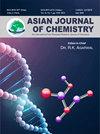Metalloproteomics: Unraveling the Metal Binding Proteins of Diverse Metal-Resistant Bacteria
Q4 Chemistry
引用次数: 0
Abstract
The release of metals into the environment raises serious concerns about their harmful effects on both the wildlife and human health. The biosphere is experiencing with the pervasive presence of heavy metal pollutants such as arsenic (As), cadmium (Cd), mercury (Hg), lead (Pb), chromium (Cr), copper (Cu) and nickel (Ni), which pose significant environmental challenges. While certain metals are essential for regulating fundamental metabolic processes and upholding the overall physiology of microorganisms, excessive exposure to heavy metals can be detrimental to their survival and function. As a result of their remarkable adaptability, microorganisms, particularly bacteria such as Pseudomonas fluorescens, Escherichia coli, Serratia marcescens, Bacillus cereus and Alcaligenes sp., have evolved sophisticated defence mechanisms to combat the stress caused by heavy metals. One such process is the creation of metal-binding proteins (MBPs), which may bind and sequester metals, thus significantly lowering their toxicity in bacteria. Metalloproteomics, a subfield of metallomics, focuses on the discovery and characterization of such metal-binding proteins (MBPs) in metal-resistant bacteria, resulting in the opening of the doors for innovative bioremediation techniques and therapeutic treatments against bacterial diseases. This review explores the intriguing world of MBPs in metal-resistant bacteria and emphasizes their significant role in metal resistance, detoxification and homeostasis. Furthermore, metallochaperones in bacteria have been extensively studied using the metalloproteomic methodologies and techniques utilized in metal-binding proteins. This study also provides useful information on the interactions between these metallochaperones and different MBPs, which advances our understanding of how bacteria respond to exposure to such heavy metals.金属蛋白质组学:揭示多种抗金属细菌的金属结合蛋白
向环境中排放金属会对野生动物和人类健康产生有害影响,这引起了人们的严重关切。生物圈中普遍存在重金属污染物,如砷(As)、镉(Cd)、汞(Hg)、铅(Pb)、铬(Cr)、铜(Cu)和镍(Ni),对环境造成了巨大挑战。虽然某些金属对于调节基本代谢过程和维持微生物的整体生理机能至关重要,但过度接触重金属会损害微生物的生存和功能。微生物,尤其是荧光假单胞菌、大肠杆菌、肉豆蔻沙雷氏菌、蜡样芽孢杆菌和钙化杆菌等细菌,由于其卓越的适应能力,已经进化出复杂的防御机制来对抗重金属造成的压力。其中一个过程就是产生金属结合蛋白(MBPs),它可以结合和螯合金属,从而大大降低金属对细菌的毒性。金属蛋白组学是金属组学的一个子领域,主要研究抗金属细菌中此类金属结合蛋白(MBPs)的发现和特征,从而为创新生物修复技术和细菌疾病治疗打开大门。这篇综述探讨了耐金属细菌中引人入胜的 MBPs 世界,并强调了它们在金属抗性、解毒和稳态中的重要作用。此外,还利用金属蛋白组学方法和金属结合蛋白技术对细菌中的金属随体进行了广泛研究。这项研究还提供了有关这些金属合体与不同 MBPs 之间相互作用的有用信息,从而加深了我们对细菌如何应对接触此类重金属的理解。
本文章由计算机程序翻译,如有差异,请以英文原文为准。
求助全文
约1分钟内获得全文
求助全文
来源期刊

Asian Journal of Chemistry
化学-化学综合
CiteScore
0.80
自引率
0.00%
发文量
229
审稿时长
4 months
期刊介绍:
Information not localized
 求助内容:
求助内容: 应助结果提醒方式:
应助结果提醒方式:


